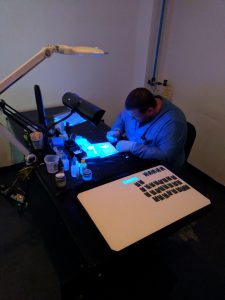Brush Application of Conformal Coating
Posted by Sean Horn
Friday, March 2, 2018 8:00
@ 8:00 AM
Conformal coatings’ functional value stems from their ability to safeguard printed circuit boards (PCBs) and similar electronics from external threats to their performance. Composed of acrylic, epoxy, silicone and urethane polymer resin, coatings also provide layers of insulative protection. These liquid coatings are applied to PCBs by wet methods, primarily by brush, dipping (component immersion) or automated/manual spraying.
Brush Application for Liquid Conformal Coatings
 The brush technique is the simplest and least expensive. As the name implies, the selected wet coating is manually applied onto the PCB with a brush, on a piece-by-piece basis. Working this way – in small production batches for uncomplicated projects – brushing offers coating specialists a comparatively easy method of conformal application, with the additional advantage of cost-effectiveness.
The brush technique is the simplest and least expensive. As the name implies, the selected wet coating is manually applied onto the PCB with a brush, on a piece-by-piece basis. Working this way – in small production batches for uncomplicated projects – brushing offers coating specialists a comparatively easy method of conformal application, with the additional advantage of cost-effectiveness.
The various liquid materials have diverse levels of viscosity; higher viscosity materials are more difficult to successfully brush onto substrates. The coating should not be applied like paint but streamed onto the PCB surface via the brush; painting-like application encourages over-coating and viscosity. UV lighting can significantly improve brushed applications. Acrylic most readily adapts to brush procedures.
Coating quality is variable with brushing, due to often exceptional disparities in operator’s skill and performance. Coating reliability depends on uniform coating thickness, essential to limiting development of defects. For instance, bubbles — air-pockets trapped under applied conformal film that void the coating layer — are a significant cause of coating failure, identified only later, during conformal coating inspection. A common error of amateur brush application is coating layers too thick or viscous, generating air-pockets unable to be released before they settle out.
Material selection when using wet coatings relies largely on the type of PCB being coated and its function; application results depend upon selection of the coating method most suitable to the film material and PCB-operation. A slow process, employed mostly for low-volume coating assignments and repair, brushing
- is poorly-matched for high volume assignments, or
- any intended for microelectricalmechanical systems (MEMS)/nano-technologies, which
- require micron-level clearances and coating-coverage.
In MEMS/nano assignments, brushing overloads the coating application, leading to poor performance and potential device failure, if the device works at all.
Thus, the relative ease of brush application can be misleading; the tendency toward poor film application is common with the brush technique, producing uneven and non-conformal coats. This major disadvantages can occur regardless of the operator’s skill-level or professional experience.
Except in cases of repair, brushing is not recommended for those PCBs whose surface topographies are complex or irregular. Brushed coating is seldom evenly applied across these surface regions of the PCB.
· Coats that are too-thick are prone to cracking, especially during thermal cycling, exposing the PCB’s inner components; external agents (chemicals, dust, moisture, oil, etc.) can completely disable the PCB or otherwise interfere with appropriate performance.
· Coating applied too-thin results in inadequate protection, similarly leaving the board vulnerable to external infiltration.
· Irregular surface-leveling during curing can develop from uneven brushing.
· Brushing allows only one side of a PCB to be coated at a time, slowing production.
In all cases, coating-thickness must adhere to assignment’s specifications, assuring applied film achieves optimal protective/insulative function; unacceptable coating performance results from inaccurate thickness, including moisture-entry into the PCB and delamination.
Summary
Brushing’s advantages include low cost, relatively simple and fast production-processing, requiring limited control in most cases. Brushing is very reliable for low volume jobs and rework. However, process quality control is limited, even in the case of expert operators. Variation of application-performance between operators is high; errors are common. Slow application speed for larger target areas is another disadvantage.
Although brushed application of conformal coating retains a range of very specific uses for low-batch assignments and repairs, other application methods – dipping, spraying – work better for larger-scale production-runs. The brush method is simple and very reliable for finishing and reworking PCBs following de-masking. If PCB surface topography is complex or the board is large, enhanced operator-skill is necessary for successful brush application of conformal coating.
At Diamond-MT, we are industry-leading coating experts, providing high-quality conformal coating services for PCBs, electronics, medical devices and more. To learn more about our offerings and discuss your next project, submit a quote form or call us at 1-814-535-3505 today.
To learn more about conformal coatings, download our whitepaper now:
Conformal Coating Process Whitepaper
Comments
Homepage 4/17/2020. 10:17:10 AM
... [Trackback] [...] Informations on that Topic: blog.paryleneconformalcoating.com/whats-the-difference-between-potting-and-conformal-coating/ [...]

londondrugscanada.bigcartel.comlondon-drugs 4/17/2020. 10:17:10 AM
cialis uk https://londondrugscanada.bigcartel.com/london-drugs This is nicely expressed. !